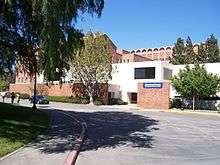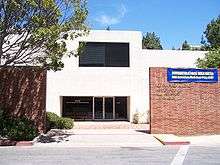Institute for Pure and Applied Mathematics
The Institute for Pure and Applied Mathematics (IPAM) is an American mathematics institute funded by the National Science Foundation. The initial funding for the institute was approved in May 1999[1] and it was inaugurated in August, 2000.[2]


IPAM is located on the UCLA campus, in close proximity to UCLA's Department of Mathematics. The building currently housing the institute was designed in 1973 by world-renowned Pritzker Prize-winning architect Frank Gehry.[3]
Mission
The mission of the institute is to make connections between a broad spectrum of mathematicians and scientists, to launch new collaborations, to better inform mathematicians and scientists about interdisciplinary problems, and to broaden the range of applications in which mathematics is used.
IPAM seeks to bring the full range of mathematical techniques to bear on the great scientific challenges of our time, to stimulate exciting new mathematics via new problems motivated by other sciences, and to train the people who will do this.[4]
Background
IPAM is currently one of seven NSF Mathematical Sciences Institutes in the United States. The initial five year grant was renewed in 2005, and this grant was once again renewed in 2010 and 2015, for an additional five years.
The institute was co-founded by Tony F. Chan, Mark Green, and Eitan Tadmor; Dima Shlyakhtenko is its current director. Christian Ratsch and Maria D'Orsogna are its current associate directors. Stanley Osher is its current special projects director.[5]
Programs
Every year IPAM offers two three-month scientific programs, or long programs. These programs bring together senior and junior mathematicians and scientists and engineers from the scientific disciplines related to the program. In addition, IPAM supports graduate students, post-doctoral scholars and young academics to encourage their participation in long programs.
The programs consist of three phases: Tutorials from both streams are offered at the beginning. These are followed by four five-day workshops focusing on particular topics related to the overall theme of the program. The programs culminate with a 1-week Oberwolfach-like workshop at the UCLA conference center at Lake Arrowhead, California.
Between the long programs, IPAM sponsors independent five-day workshops on a broad range of scientific themes. During the summer IPAM holds a research program for undergraduates (RIPS) focusing on industrial problems as well as a summer school for graduate students. The graduate student summer school is dedicated to an important scientific theme involving problems of mathematical interest.
References
- "NSF Opts for Three Institutes: UCLA's IPAM To Join IMA, MSRI".
- "Inaugural Lectures and Opening Reception Program". Archived from the original on 2006-12-08. Retrieved 2007-06-30.
- "Newest NSF Institute Open Its Doors, Notices of the AMS, Volume 47, Number 11".
- "IPAM — About Page". Archived from the original on 2007-06-30. Retrieved 2007-06-30.
- "IPAM — Directors Page". Archived from the original on 2013-09-14. Retrieved 2007-06-30.